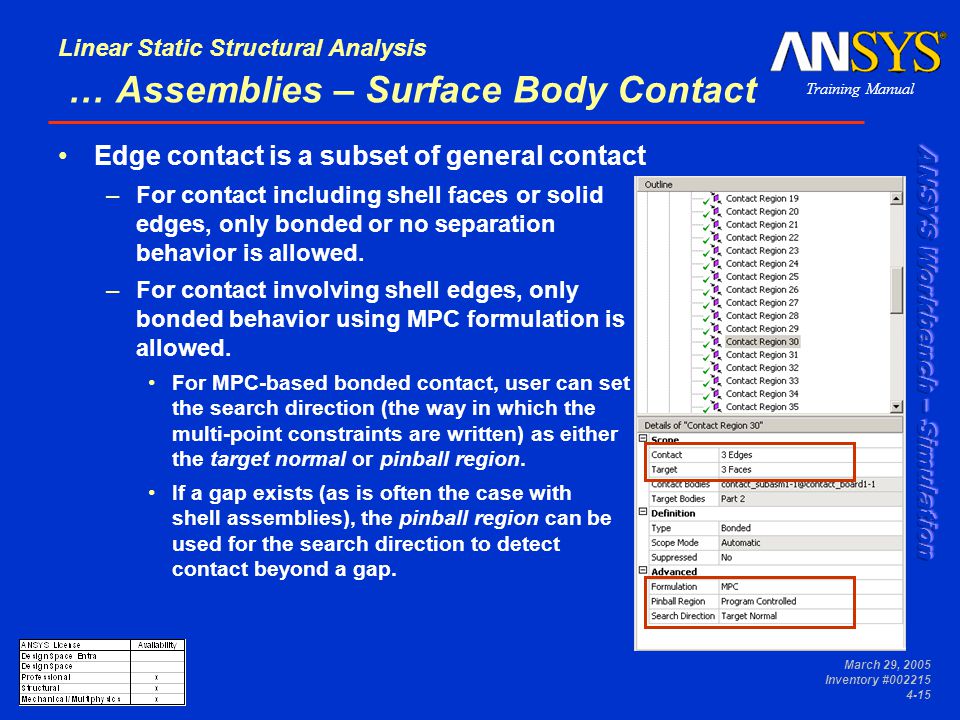

#ANSYS 15 STRUCTURAL ANALYSIS GUIDE FREE#
Rocky DEM can replicate complex motions within its UI, including combined motions and particle-induced free body motion with 6 degrees of freedom. Design of experiments within Ansys Workbench to generate a response surface and assess the impact of geometry and process changes. This integration also allows engineers to use design exploration systems to perform automated design explorations such as run DOEs, generate response surfaces with well-defined input and output parameters as shown in Figure 3, or even run goal-driven optimizations. Integration of Rocky DEM into Ansys Workbench.Īs parameters are managed at the project level, it is simple to define multiple parametric cases and effortlessly evaluate key design parameters and operational conditions to assess equipment performance or perform what-if studies with a set of design points. The two programs together enable engineers to realistically model granular materials and their complex behaviors by including different physics in the analysis, evaluating a wider range of scenarios, generating results that are closer to real life. The tight integration between Rocky DEM and other component applications within the Ansys Workbench platform makes the setup of complex multiphysics simulations easy.
#ANSYS 15 STRUCTURAL ANALYSIS GUIDE SOFTWARE#
Rocky DEM is fully integrated into Ansys Workbench (Figure 2) and does not require any other external software for coupling. This animation shows how the instantaneous bulk material loads on a bucket excavator are captured. With the latter program, engineers can simulate transient cases while incorporating geometry motion and time-varying loads on boundary elements. Why use Rocky DEM for DEM-FEA coupling?Ĭhoosing Rocky DEM for structural analysis provides great value, as can be seen from the following highlights:īoth static and transient structural analysis problems can be solved using Rocky DEM and Ansys Mechanical.

Exporting loads from Rocky DEM for static structural simulation within Rocky DEM. Figure 1 shows how the loads are exported from the DEM simulation for static structural analysis. These loads are then exported as a pressure field for further analysis using Ansys Mechanical, which discretizes the geometry and then solves for the equilibrium condition as discussed above.

Coupling Principleĭuring a simulation, Rocky DEM tracks the particle loads on each node of the geometry mesh. For transient simulations, the equilibrium conditions account for both deformation and kinematic energies, while for static simulations, only the deformation is considered. For a given load, FEA software such as Ansys Mechanical solves for an equilibrium condition in the structure. With its ability to handle large particle counts of real shapes and sizes to provide a quick and accurate prediction of process performance, Rocky DEM is used across multiple industrial sectors, including mining, heavy machinery, agricultural, chemical, and pharmaceuticals.įEA is widely used for structural analysis in the civil, automotive, and aeronautic sectors. By taking into account all the forces acting on each particle in the bulk system, DEM brings insight into how these materials would perform within the given equipment over a range of process conditions. Today, DEM is an integral tool across many industries that handle bulk material like rocks, soil, powdered chemicals, potato chips, and pharmaceutical tablets. This physical prototyping approach involves a lot of time, cost, and physical effort.Īlternately, you can try what engineers throughout the world are doing – use high-fidelity simulation tools like Discrete Element Method (DEM) and Finite Element Analysis (FEA) to optimize the process and design parameters virtually. Then in the likely event it fails on the first trial, make design changes based on your best assessment and try again. One way is to start with a known design, run some hand calculations with due assumptions, and perform a field test. Imagine you’re tasked with designing a bucket conveyor or a loader at a given throughput. Updated from original publication on: June 5, 2019


 0 kommentar(er)
0 kommentar(er)
